Scientists suggest that about 2/3 of the world's population is affected by this disease or parasitic disease. Among the various parasites in the human body there are the most dangerous, which not only cause discomfort to the patient, but can also lead to the emergence of dangerous complications, up to and including death. In our article we will tell you all about parasites, that is, we will describe the most terrible parasites and list the symptoms of the most dangerous helminthiases.
Variety of parasites
There are many types of worms and protozoa that live in the human body:
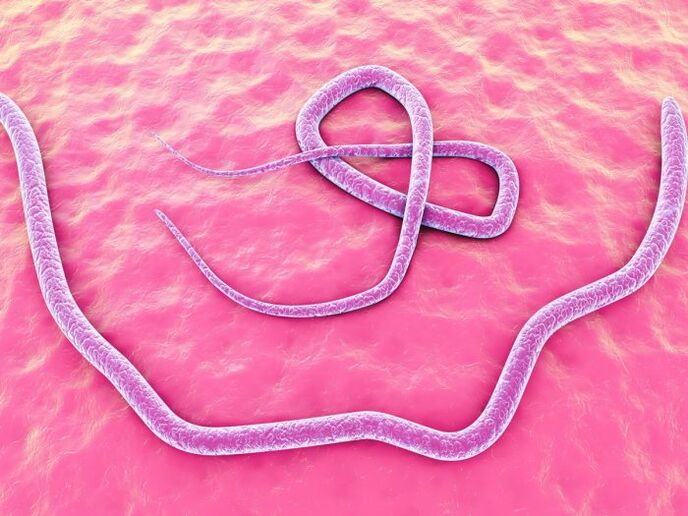
- Helminths. These worms most often live in the intestines, but it is possible that they settle in the liver, brain, lungs, heart, kidneys, muscles and other organs. Worms trigger dangerous diseases and complications.
- Parasitic and multicellular protozoa (protozoan parasites). These pests commonly occur at different latitudes. These human protozoa parasites can infect the intestines, eyes, brain, esophagus, heart, muscles, as well as nerves, liver, skin, and even the genitourinary system. The most common protozoan parasites living in humans are lichen, lamblia, toxoplasma, Trichomonas, blastocysts, etc.
- Other organisms that are also parasites for humans are fleas, ticks, ticks, flying larvae. Their name is ectoparasites. They can parasitize not only on the surface of the skin, but also on wounds, hair follicles and eyelashes.
- Other parasites are species that more frequently affect subcutaneous tissue, but can be parasitic on the urethra and nasopharynx. These are the larvae of some flies, mosquitoes, sand lice.
We have listed the main types of parasites in humans. But if we discuss the types of parasites that live in the human body in our latitudes, then the most horrible are the following:
- pig tapeworm;
- broadband;
- pinworms;
- Chinese coincidence;
- ringworm;
- coincidence;
- Trichinella;
- alveococcus;
- whip worm
- dwarf tapeworm;
- bullish tapeworm;
- happiness of the heart;
- lung coincidence;
- echinococcus.
The disease it causes
The most dangerous parasites that live in the human body can trigger various diseases. Often, a disease provoked by a particular parasite has the same name as the disease. Therefore, various types of parasites in the human body can cause the following diseases:
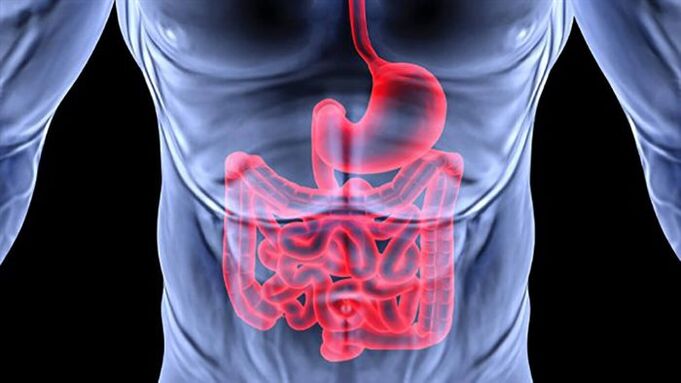
- certain parasites in a person (flukes) provoke trematodes;
- cestodosis occurs when tapeworms are affected;
- if an adult or child has tapeworms in the gut, then nematodes are diagnosed;
- leeches cause hirudinosis;
- Anthocephalosis is provoked by scratching.
However, parasites in the human body can infect more than one organ. Depending on the localization of the parasite in the human body, the following parasitic diseases are distinguished:
- If the eye is affected, onchocerciasis, demodicosis, cysticercosis and myiasis may occur;
- Diseases of the gastrointestinal tract, caused by unicellular parasites and helminths, - ascariasis, trichinosis, ankylostomiasis, enterobiasis, intestinal myiasis and metagonimiasis;
- Brain diseases - echinococcosis, toxoplasmosis, alveococcosis and cysticercosis;
- Dermatological diseases - demodicosis, head lice, scabies, pulicosis, thrombidiasis, phthiriasis;
- Lung pathology - echinococcosis, ascariasis, acariasis, alveococcosis, tominxosis, etc. ;
- Liver disease - opisthorchiasis, alveococcosis, echinococcosis, clonorchiasis;
- In the mouth, ears and mouth, parasites can cause various types of myiasis;
- Cardiac pathology - dirofilariasis and echinococcosis;
- Diseases of the genitourinary system - alveococcosis, venous myiasis, echinococcosis;
- Vascular pathology - filariasis and schistosomiasis.
Symptoms
What are parasites in the human body, which we have considered. Now let’s look at the main symptoms caused by the simplest human parasites and various types of worms. Keep in mind that cysts of pathogenic worms and protozoa are often the cause of infection, which can stay in the external environment for a long time, waiting for the right moment.  When in a good state of one's internal environment, larvae emerge from cysts, which actively develop into adults.
When in a good state of one's internal environment, larvae emerge from cysts, which actively develop into adults.
Separately, it is necessary to explain what a cyst is. Often, cysts form the simplest unicellular organisms, bacteria and protists. Protozoan cysts are a temporary form of the existence of an organism in poor condition. In fact, it is protective. Cyst formation occurs at some stage in the life cycle of the parasite or in unfavorable conditions.
Ascariasis
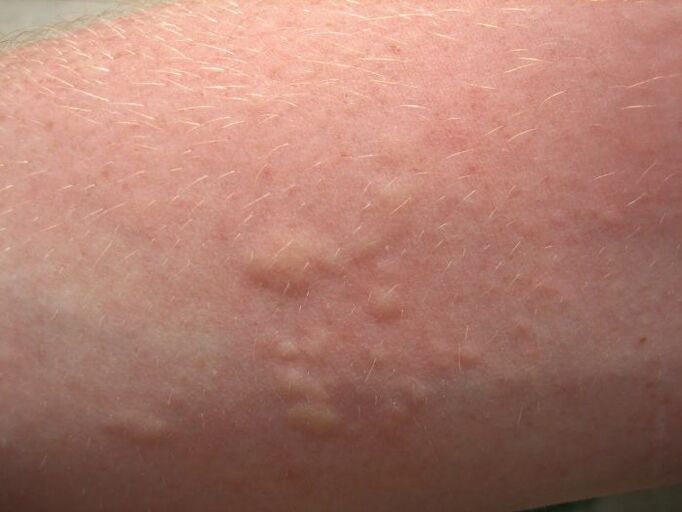
This disease is caused by ringworm. These parasites can live exclusively in the human intestine. The complex of symptoms depends on the intensity of the invasion and the age of the patient. Common symptoms of this disease are:
- itchy allergic rash (such as vesicular rash or urticaria);
- feverish condition;
- general discomfort;
- excessive sweating;
- weakness;
- enlarged liver;
- at migration stage: shortness of breath, cough, wheezing in the lungs;
- loss of appetite;
- diarrhea and constipation;
- loya;
- from the side of the central nervous system: irritability, sleep and memory disturbances, seizures, meningitis;
- Liver abscesses, obstructive jaundice, appendicitis, pancreatitis and obstruction can develop with massive invasion.
Teniarinhoz
This disease causes bovine tapeworm. In the early stages, the disease is asymptomatic and can last for years. Sooner or later, the following symptoms appear:
- heaviness in the epigastrium;
- nausea, heartburn;
- increased salivation;
- choking;
- appendicitis, intestinal obstruction, bile duct obstruction;
- weight loss with a background of increased appetite;
- vitamin deficiency;
- allergic reactions;
- dizziness, weakness, sleep disturbances, increased restlessness and irritability;
- arterial hypertension and tachycardia.
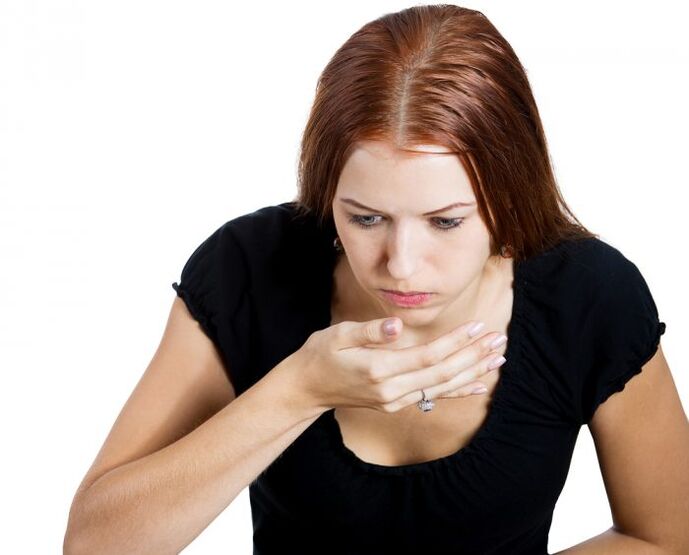
Enterobiasis
Pinworms cause this disease. This is the most common parasitic disease. The symptoms are as follows:
- itching in the anus, worse at night;
- scratching and redness in this area;
- sleepiness, bruxism, drowsiness, lethargy appear;
- loss of appetite;
- abdominal pain, urinary discomfort in children;
- unstable stools, nausea, bloating, vomiting;
- allergic reactions.
Toxocariasis

Toxocara worms can perform parasites in various tissues and organs of a person. But regardless of the place of localization, they always cause allergic reactions in the body, running according to the following types:
- The skin rash resembles a mosquito bite. The rash can appear on various parts of the body.
- Bronchial asthma, manifested as a persistent dry cough with a small amount of sputum.
- Edema Quincke. A person experiences swelling of the skin on the face and neck, which can lead to suffocation and death.
With the increase of toxocariasis, the patient's temperature rises, symptoms of intoxication with loss of appetite and headache appear, the lymph nodes increase.
Necatorosis (mine worm)
This disease is caused by worms called nekator and mine worms. This invasion is indicated by the following symptom complex:
- When larvae are introduced through the skin, dermatitis, urticaria, and various rashes appear. At the site of penetration, there is swelling, itching and burning. The invasive period lasts up to 12 days.
- The migration stage is also accompanied by allergic manifestations. In this case, the airways are injured, and bronchitis, pneumonia, tracheitis and laryngitis occur. The patient experienced fever, cough, shortness of breath and a hoarse voice.
- Within a few months, the intestinal stage of the disease begins. At this stage, there are symptoms of iron deficiency anemia and duodenitis. Patients experience increased irritability, fatigue and sleep disturbances. Women experience menstrual irregularities.
Important! In childhood, tapeworm infections can cause mental and physical retardation.
Giardiasis
Giardia is a parasitic protozoan disease. A quarter of the population has asymptomatic transport of microorganisms. In the acute stage, the following symptoms appear:
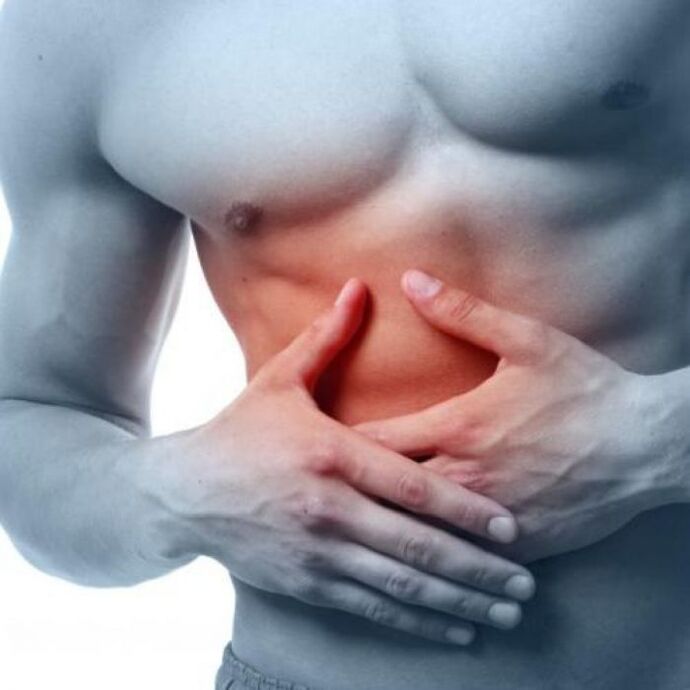
- impaired gastrointestinal tract function;
- the patient is tormented by pain in the right hypochondrium and the area around the umbilicus;
- bloating, decreased appetite, belching, nausea were observed;
- diarrhea alternates with constipation, there may be frequent frothy stools (up to 5 times);
- with subacute course, persistent intestinal symptoms, patients lose weight;
- with intoxication and a fever of great aggression;
- children experience pruritus, itching and fainting;
- during coprogramme protozoan cysts were found in feces.
Amoebiasis
The disease is caused by histological amoebae. The disease can occur without symptoms or signs. There are two forms of the disease: extraintestinal and intestinal. These protozoa can affect the brain, lungs, skin, and genitourinary system. But the most common is intestinal amebiasis. The symptoms are as follows:
- at the beginning of the disease, diarrhea appears with copious frothy stools, then jelly-like stools, like raspberry jelly, come out. Their frequency is up to 20 times a day;
- severe pain localized on the right side of the abdomen;
- slightly subfebrile condition;
- after 6 weeks the acute process may decrease; Examination of
- can reveal protozoa in feces.
Important! Amoebiasis will not go away on its own and often recur. If left untreated, amoebae form, which cause intestinal obstruction.
Diphyllobothriasis

Widespread tapeworms are the cause of this disease. Representatives of this cestode cause the following clinical picture of the disease:
- weight loss, erratic stools, decreased appetite;
- low temperature;
- fatigue;
- abdominal cramps;
- anemia, weakness, dizziness, increased heart rate;
- worm fragments can be found in feces;
- painful cracks appear in the mouth;
- depression and increased irritability.
Teniosis
This disease is caused by pig tapeworms. The parasite is localized in the small intestine and causes the following symptoms:
- constipation, vomiting, diarrhea, nausea;
- vomit and stool may contain segments (proglottid) of the parasite;
- anal itching, abdominal pain;
- sleep soundly, dizziness appears.
Echinococcosis
Echinococcus can be asymptomatic for a long time. Then pain appears in the area of echinococcal cyst formation. Usually, the symptoms are characteristic of neoplasms of certain organs. When the cyst ruptures, general intoxication, anaphylactic shock, and urticaria appear.
Types of parasites that live in the human body
All types of parasites in the human body adversely affect his health. They infect organs, consume nutrients necessary for human life, and release harmful toxic substances. Therefore, it is very important to get rid of them on time.
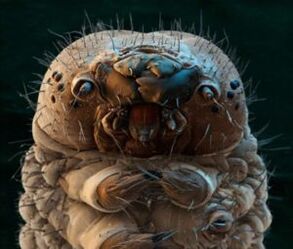
The human body is affected by various parasites, some living inside the body, others on its surface. Its size varies, the way it enters the body, in its important functional characteristics.
What parasites live in the human body? How to get rid of them? What precautions are there? These issues will be discussed below.
Classification of parasites
Human parasites are very common, they are divided into several groups:
- Endoparasitesare organisms that do parasites in a person. This group, in turn, is divided into protozoa (consisting of a single cell) and helminths (worms). The simplest parasites in the human body are amoeba, lamblia, Trichomonas, toxoplasma. As for worms, here again there is a division into roundworms (nematodes), flatworms and tapeworms.
- Ectoparasitesare organisms that parasitize the surface of the human body - lice, fleas, fleas, rotten lice. In addition to the fact that they consume human blood, causing discomfort (bites, burning, skin lesions), they carry quite dangerous diseases: typhoid, anthrax, trypanosomiasis and others.
- Giardia.Giardiasis infection is a fecal-oral mechanism. After cysts (unformed parasites, covered with a protective membrane) are removed from the anus of a sick person, they spread to vegetables, fruits and other food products. Through unwashed hands, stagnant water, inadequately washed fruits and vegetables, cysts enter the human oral cavity, from where they safely reach the intestines, where they re-transform into adults and reproduce again. The result is a vicious cycle that will continue until adequate treatment and hygiene measures are followed. Symptoms of the disease are weakness, fatigue, headache, diarrhea, abdominal pain, and bloating. Itching in the anus, skin rash, bronchial asthma may occur. The pathology is characterized by weight loss, anemia, and weakened immune system. Treatment - Metronidazole, Furazolidone, Tinidazole. The dose is prescribed by a doctor.
- Toxoplasma.Infection with these protozoa occurs through contact with infected pets. In this case, a person is an intermediate host, because the cycle of sexual development of the parasite takes place in the body of the animal. The disease is manifested by a prolonged increase in temperature to subfebrile levels, signs of general intoxication, the patient experiences enlarged lymph nodes, joint and muscle pain appear. Also, gastrointestinal and visual tract function is disturbed, the central nervous system may suffer, there are signs of heart disease and the endocrine system. Complex treatment is prescribed - antibiotics of the tetracycline and sulfonamide groups.
- Trichomonas.Trichomonas is sexually transmitted, the risk of infection through contact is minimal, but still present. Symptoms of the disease in women are itching, redness on the genitals, burning sensation and whiteness. Men may have difficulty urinating and experience vaginal discharge. Treatment - anti -trichomonas drugs.
Pinworm is an intestinal parasite
The most well -known internal parasite is the cream worm. They live in the gut and cause a disease called enterobiasis. This type of parasite attacks not only humans, but also monkeys. Risk group-children of preschool age, according to statistics, enterobiasis is diagnosed in half of children from 2 to 10 years.
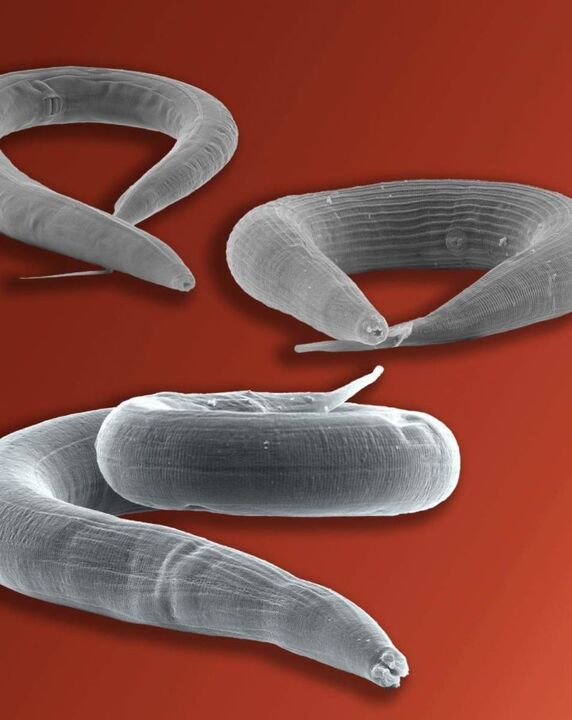
Worms are transmitted from person to person, you can be infected through objects used by sick people, or through handshakes. The main condition for the transfer of cream worm eggs is not washed hands after contact, especially before eating. Worms, or rather their eggs, can be carried by flies and cockroaches.
Cream worms can only live in the intestines, they are very comfortable in the thin part, in the large intestine and cecum. To mate, the parasite selects the ileum, from which the female crawls out through the anus and lays eggs in the anus. Symptoms of cream worms in the body are itching in the anus, allergies, fatigue, anemia, abdominal pain, fatigue.
Levamisole, mebendazole, albendazole and other anthelmintic drugs are prescribed for the treatment of enterobiasis. Cream worm prevention based on hand hygiene. They must be washed after visiting any public place.
Roundworms - roundworms
The length of an adult can reach 40 cm. Roundworms live in the human intestine, their eggs hatch naturally, then they continue their development in the soil, where they live until they enter the human body again. Dirty hands and unwashed vegetables and fruits are a way of ringworm infection. Roundworm eggs are covered with an insoluble shell in the human stomach and allow roundworms to survive and enter the intestine, where adult individuals develop.
Ascariasis can be asymptomatic for a long time. Then symptoms appear, which depend on the location and phase of development of the parasite. In the first phase of ascariasis, patients worry about fever, cough with sputum, skin rash, migraine, enlarged lymph nodes, liver and spleen may appear. In the final phase, when the parasite has entered the intestine, stool disturbances are observed (dysentery, symptoms such as cholera, signs of typhoid fever may occur). There is a painful sensation in the abdomen, a sharp weight loss, and fatigue.
Broadband
Infection with this parasite occurs through fish. This is a worm intermediary host. Not to be eaten for infection, sometimes enough contact with infected fish. That is why it is very important to handle hands, knives, boards carefully after cutting the fish.
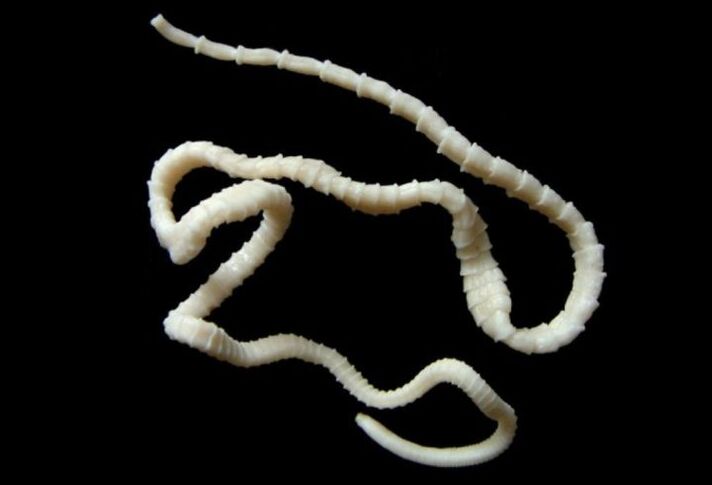
Worms and their larvae are not transmitted from sick people to healthy people. Symptoms of infection are nausea, vomiting, abdominal pain, increased or decreased appetite, dyspeptic disorders. The first signs of the disease may appear a month or two after infection. As a result of the long -term presence of parasites in the human body, pale skin, headache, increased heart rate, decreased blood pressure, weakness, anemia occur. Treatment aims to kill worms. To do this, use Praziquantel, Niclosamide.
Bull tapeworm
Cow tapeworms can grow up to 12 m. It is a hermaphrodite that can produce more than 100, 000 eggs, which are excreted in feces. Eggs fall into the ground, then into crops, these crops are eaten by cows. In the animal's body, the eggs become larvae, which are localized in the muscles. If a person eats contaminated beef, the larvae enter the intestines. Larvae are not spread from person to person.
Adult worms have a head with four suction cups, a neck, and a body consisting of segments. The number of segments continues to increase, mature segments are able to separate from the worms and crawl out of the human intestine.
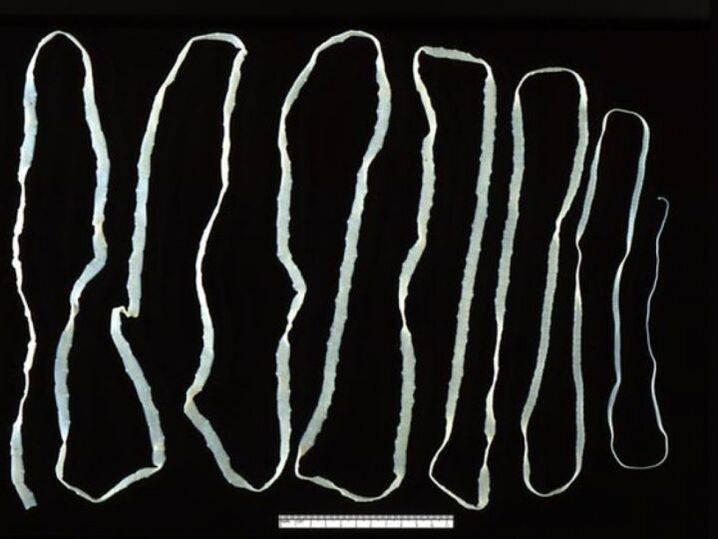
Symptoms of the disease are nausea, vomiting, dyspeptic disorders, increased salivation, dizziness, weakness, restlessness, fatigue, erratic localization abdominal pain, allergies, fluctuations in appetite.
To remove tapeworms from the body, there is a scheme consisting of 3 stages: preparation (cleansing the body), treatment with antiparasitic drugs (Biltricid, Praziquantel, Niclosamide), rehabilitation (diet, herbal medicine).
Pig tapeworm
A person can be infected with pig tapeworms through dirty hands, poorly cooked meat, dirty water, an infected person can release tapeworm segments and larvae into the environment with vomit and feces. 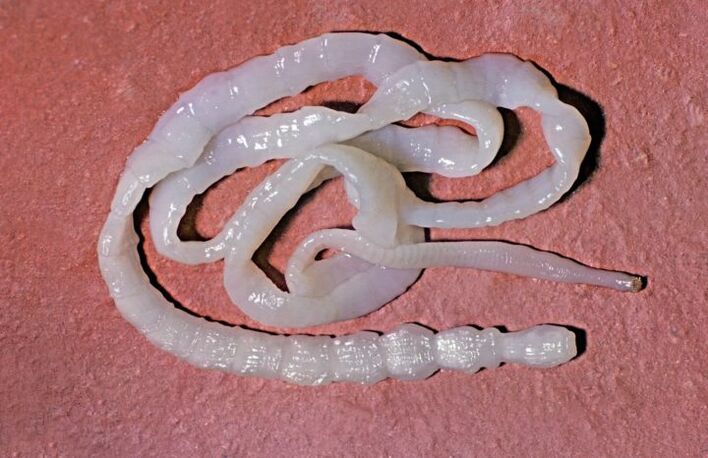 These worms can live in the human body for up to 15-17 years, attach to the intestinal mucosa, and the larvae can spread throughout the body with blood flow and attach to any organ. It is very dangerous if the larvae enter the brain.
These worms can live in the human body for up to 15-17 years, attach to the intestinal mucosa, and the larvae can spread throughout the body with blood flow and attach to any organ. It is very dangerous if the larvae enter the brain.
Pigs are intermediate hosts; people who come in frequent contact with raw meat are at risk of contracting this parasite. Pork chains can be infected through contact and eating meat that has not been treated with heat. In order for all pig tapeworm larvae to be crushed in the meat, the meat must be cooked long or frozen for 2-3 weeks.
Pig tapeworms can affect the small intestine, liver, brain, visual organs, muscles, etc. If tapeworms affect vital organs, then a person may suffer paralysis or even death.
Symptoms of tapeworm: allergic reactions, abdominal pain, nausea and vomiting, weakness, dizziness, headache, weight loss, itching in the anus. The worms infect the intestinal mucosa, so the symptoms are very similar to enteritis.
Treatment involves taking a drug that has a paralyzing effect on the worm, as a result of which it cannot stay in the intestinal wall and come out. But at the same time, it releases large amounts of toxic substances, which can cause anaphylactic shock in a person. Therefore, treatment can only be performed under the supervision of a physician.
Parasites in the mouth
Parasites in the human mouth are most commonly represented by the following species:
- Trichomonas;
- amoeba mouth;
- Larva diptera (oral myiasis).
The clinical picture may be as follows:
- allergies;
- weakness, weight loss;
- fetid odor from the mouth;
- sensation of movement in the larynx;
- itching and sweating;
- nausea, loss of energy.
Worms that live in the mouth can destroy teeth, causing purulent deposits on the mucous membranes and tongue. Treatment is only prescribed by a doctor who takes into account the symptoms present, as well as the type of parasite. A prerequisite for treatment is an examination of everyone in contact with the patient.
Summary
Above, not all are considered, even the most common parasites that can inhabit the human body. It is important to understand the great dangers of the area: worms in a person can cause very serious consequences and eventually lead to the death of its owner. Therefore, it is very important to diagnose parasites in a timely manner and get rid of them. As for preventive measures, it usually consists of hygiene and grilling of high quality meat eaten.






































